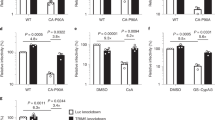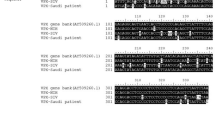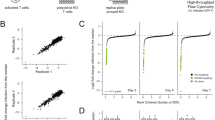Abstract
Rhesus macaque tripartite motif (TRIM)5α potently inhibits early stages of human immunodeficiency virus (HIV)-1 replication, while the human orthologue has little effect on this virus. We used PCR-based random mutagenesis to construct a large library of human TRIM5α variants containing mutations in the PRYSPRY domain. We then applied a functional screen to isolate human cells made resistant to HIV-1 infection by the expression of a mutated TRIM5α. This protocol led to the characterization of a human TRIM5α variant containing a mutation at arginine 335 as conferring resistance to HIV-1 infection. The level of protection stemming from expression of this mutant was comparable to that of previously described mutations at position 332. R332/R335 double mutants decreased permissiveness to HIV-1 and to other lentiviruses by 20- to 50-fold in TE671 fibroblasts and in the T-cell line SUP-T1, and prevented HIV-1 spreading infection as efficiently as the rhesus macaque TRIM5α orthologue did. The finding that only two substitutions in human TRIM5α can confer resistance to HIV-1 at levels as high as one of the most potent natural orthologues of TRIM5α removes a roadblock toward the use of this restriction factor in human gene therapy applications.
This is a preview of subscription content, access via your institution
Access options
Subscribe to this journal
Receive 12 print issues and online access
$259.00 per year
only $21.58 per issue
Buy this article
- Purchase on Springer Link
- Instant access to full article PDF
Prices may be subject to local taxes which are calculated during checkout





Similar content being viewed by others
References
Reymond A, Meroni G, Fantozzi A, Merla G, Cairo S, Luzi L et al. The tripartite motif family identifies cell compartments. Embo J 2001; 20: 2140–2151.
Meroni G, Diez-Roux G . TRIM/RBCC, a novel class of ‘single protein RING finger’ E3 ubiquitin ligases. Bioessays 2005; 27: 1147–1157.
Stremlau M, Owens CM, Perron MJ, Kiessling M, Autissier P, Sodroski J . The cytoplasmic body component TRIM5alpha restricts HIV-1 infection in Old World monkeys. Nature 2004; 427: 848–853.
Perron MJ, Stremlau M, Song B, Ulm W, Mulligan RC, Sodroski J . TRIM5alpha mediates the postentry block to N-tropic murine leukemia viruses in human cells. Proc Natl Acad Sci USA 2004; 101: 11827–11832.
Hatziioannou T, Perez-Caballero D, Yang A, Cowan S, Bieniasz PD . Retrovirus resistance factors Ref1 and Lv1 are species-specific variants of TRIM5alpha. Proc Natl Acad Sci USA 2004; 101: 10774–10779.
Bieniasz PD . Intrinsic immunity: a front-line defense against viral attack. Nat Immunol 2004; 5: 1109–1115.
Luban J . Cyclophilin A, TRIM5, and resistance to human immunodeficiency virus type 1 infection. J Virol 2007; 81: 1054–1061.
Towers GJ . The control of viral infection by tripartite motif proteins and cyclophilin A. Retrovirology 2007; 4: 40.
Nisole S, Stoye JP, Saib A . TRIM family proteins: retroviral restriction and antiviral defence. Nat Rev Microbiol 2005; 3: 799–808.
Keckesova Z, Ylinen LM, Towers GJ . The human and African green monkey TRIM5alpha genes encode Ref1 and Lv1 retroviral restriction factor activities. Proc Natl Acad Sci USA 2004; 101: 10780–10785.
Yap MW, Nisole S, Lynch C, Stoye JP . Trim5alpha protein restricts both HIV-1 and murine leukemia virus. Proc Natl Acad Sci USA 2004; 101: 10786–10791.
Kratovac Z, Virgen CA, Bibollet-Ruche F, Hahn BH, Bieniasz PD, Hatziioannou T . Primate lentivirus capsid sensitivity to TRIM5 proteins. J Virol 2008; 82: 6772–6777.
Zhang F, Hatziioannou T, Perez-Caballero D, Derse D, Bieniasz PD . Antiretroviral potential of human tripartite motif-5 and related proteins. Virology 2006; 353: 396–409.
Johnson WE, Sawyer SL . Molecular evolution of the antiretroviral TRIM5 gene. Immunogenetics 2009; 61: 163–176.
Sebastian S, Luban J . TRIM5alpha selectively binds a restriction-sensitive retroviral capsid. Retrovirology 2005; 2: 40.
Stremlau M, Perron M, Lee M, Li Y, Song B, Javanbakht H et al. Specific recognition and accelerated uncoating of retroviral capsids by the TRIM5alpha restriction factor. Proc Natl Acad Sci USA 2006; 103: 5514–5519.
Perez-Caballero D, Hatziioannou T, Zhang F, Cowan S, Bieniasz PD . Restriction of human immunodeficiency virus type 1 by TRIM-CypA occurs with rapid kinetics and independently of cytoplasmic bodies, ubiquitin, and proteasome activity. J Virol 2005; 79: 15567–15572.
Hatziioannou T, Cowan S, Von Schwedler UK, Sundquist WI, Bieniasz PD et al. Species-specific tropism determinants in the human immunodeficiency virus type 1 capsid. J Virol 2004; 78: 6005–6012.
Ikeda Y, Ylinen LM, Kahar-Bador M, Towers GJ . Influence of gag on human immunodeficiency virus type 1 species-specific tropism. J Virol 2004; 78: 11816–11822.
Owens CM, Song B, Perron MJ, Yang PC, Stremlau M, Sodroski J . Binding and susceptibility to postentry restriction factors in monkey cells are specified by distinct regions of the human immunodeficiency virus type 1 capsid. J Virol 2004; 78: 5423–5437.
Berube J, Bouchard A, Berthoux L . Both TRIM5alpha and TRIMCyp have only weak antiviral activity in canine D17 cells. Retrovirology 2007; 4: 68.
Perron MJ, Stremlau M, Lee M, Javanbakht H, Song B, Sodroski J . The human TRIM5alpha restriction factor mediates accelerated uncoating of the N-tropic murine leukemia virus capsid. J Virol 2007; 81: 2138–2148.
Anderson JL, Campbell EM, Wu X, Vandegraaff N, Engelman A, Hope TJ . Proteasome inhibition reveals that a functional preintegration complex intermediate can be generated during restriction by diverse TRIM5 proteins. J Virol 2006; 80: 9754–9760.
Diaz-Griffero F, Li X, Javanbakht H, Song B, Welikala S, Stremlau M et al. Rapid turnover and polyubiquitylation of the retroviral restriction factor TRIM5. Virology 2006; 349: 300–315.
Yamauchi K, Wada K, Tanji K, Tanaka M, Kamitani T . Ubiquitination of E3 ubiquitin ligase TRIM5 alpha and its potential role. Febs J 2008; 275: 1540–1555.
Rold CJ, Aiken C . Proteasomal degradation of TRIM5alpha during retrovirus restriction. PLoS Pathog 2008; 4: e1000074.
Campbell EM, Perez O, Anderson JL, Hope TJ . Visualization of a proteasome-independent intermediate during restriction of HIV-1 by rhesus TRIM5alpha. J Cell Biol 2008; 180: 549–561.
Wu X, Anderson JL, Campbell EM, Joseph AM, Hope TJ . Proteasome inhibitors uncouple rhesus TRIM5alpha restriction of HIV-1 reverse transcription and infection. Proc Natl Acad Sci USA 2006; 103: 7465–7470.
James LC, Keeble AH, Khan Z, Rhodes DA, Trowsdale J . Structural basis for PRYSPRY-mediated tripartite motif (TRIM) protein function. Proc Natl Acad Sci USA 2007; 104: 6200–6205.
Perez-Caballero D, Hatziioannou T, Yang A, Cowan S, Bieniasz PD . Human tripartite motif 5alpha domains responsible for retrovirus restriction activity and specificity. J Virol 2005; 79: 8969–8978.
Song B, Gold B, O’Huigin C, Javanbakht H, Li X, Stremlau M et al. The B30.2(SPRY) domain of the retroviral restriction factor TRIM5alpha exhibits lineage-specific length and sequence variation in primates. J Virol 2005; 79: 6111–6121.
Ohkura S, Yap MW, Sheldon T, Stoye JP . All three variable regions of the TRIM5alpha B30.2 domain can contribute to the specificity of retrovirus restriction. J Virol 2006; 80: 8554–8565.
Sawyer SL, Wu LI, Emerman M, Malik HS . Positive selection of primate TRIM5alpha identifies a critical species-specific retroviral restriction domain. Proc Natl Acad Sci USA 2005; 102: 2832–2837.
Ortiz M, Bleiber G, Martinez R, Kaessmann H, Telenti A . Patterns of evolution of host proteins involved in retroviral pathogenesis. Retrovirology 2006; 3: 11.
Stremlau M, Perron M, Welikala S, Sodroski J . Species-specific variation in the B30.2(SPRY) domain of TRIM5alpha determines the potency of human immunodeficiency virus restriction. J Virol 2005; 79: 3139–3145.
Li Y, Li X, Stremlau M, Lee M, Sodroski J . Removal of arginine 332 allows human TRIM5alpha to bind human immunodeficiency virus capsids and to restrict infection. J Virol 2006; 80: 6738–6744.
Yap MW, Nisole S, Stoye JP . A single amino acid change in the SPRY domain of human Trim5alpha leads to HIV-1 restriction. Curr Biol 2005; 15: 73–78.
Rossi JJ, June CH, Kohn DB . Genetic therapies against HIV. Nat Biotechnol 2007; 25: 1444–1454.
Mitsuyasu RT, Merigan TC, Carr A, Zack JA, Winters MA, Workman C et al. Phase 2 gene therapy trial of an anti-HIV ribozyme in autologous CD34+ cells. Nat Med 2009; 15: 285–292.
Coffin JM . HIV population dynamics in vivo: implications for genetic variation, pathogenesis, and therapy. Science 1995; 267: 483–489.
Anderson J, Akkina R . Complete knockdown of CCR5 by lentiviral vector-expressed siRNAs and protection of transgenic macrophages against HIV-1 infection. Gene Ther 2007; 14: 1287–1297.
Lee MT, Coburn GA, McClure MO, Cullen BR . Inhibition of human immunodeficiency virus type 1 replication in primary macrophages by using Tat- or CCR5-specific small interfering RNAs expressed from a lentivirus vector. J Virol 2003; 77: 11964–11972.
Perez EE, Wang J, Miller JC, Jouvenot Y, Kim KA, Liu O et al. Establishment of HIV-1 resistance in CD4+ T cells by genome editing using zinc-finger nucleases. Nat Biotechnol 2008; 26: 808–816.
Berthoux L, Sebastian S, Sayah DM, Luban J . Disruption of human TRIM5alpha antiviral activity by nonhuman primate orthologues. J Virol 2005; 79: 7883–7888.
Goldschmidt V, Ciuffi A, Ortiz M, Brawand D, Muñoz M, Kaessmann H et al. Antiretroviral activity of ancestral TRIM5alpha. J Virol 2008; 82: 2089–2096.
Sebastian S, Grütter C, Strambio de Castillia C, Pertel T, Olivari S, Grütter MG et al. An invariant surface patch on the TRIM5alpha PRYSPRY domain is required for retroviral restriction but dispensable for capsid binding. J Virol 2009; 83: 3365–3373.
Song B, Javanbakht H, Perron M, Park DH, Stremlau M, Sodroski J . Retrovirus restriction by TRIM5alpha variants from Old World and New World primates. J Virol 2005; 79: 3930–3937.
Ylinen LM, Keckesova Z, Wilson SJ, Ranasinghe S, Towers GJ . Differential restriction of human immunodeficiency virus type 2 and simian immunodeficiency virus SIVmac by TRIM5alpha alleles. J Virol 2005; 79: 11580–11587.
Bock M, Bishop KN, Towers G, Stoye JP . Use of a transient assay for studying the genetic determinants of Fv1 restriction. J Virol 2000; 74: 7422–7430.
Towers G, Bock M, Martin S, Takeuchi Y, Stoye JP, Danos O . A conserved mechanism of retrovirus restriction in mammals. Proc Natl Acad Sci USA 2000; 97: 12295–12299.
Passerini LD, Keckesova Z, Towers GJ . Retroviral restriction factors Fv1 and TRIM5alpha act independently and can compete for incoming virus before reverse transcription. J Virol 2006; 80: 2100–2105.
Cowan S, Hatziioannou T, Cunningham T, Muesing MA, Gottlinger HG, Bieniasz PD . Cellular inhibitors with Fv1-like activity restrict human and simian immunodeficiency virus tropism. Proc Natl Acad Sci USA 2002; 99: 11914–11919.
Carthagena L, Parise MC, Ringeard M, Chelbi-Alix MK, Hazan U, Nisole S . Implication of TRIM alpha and TRIMCyp in interferon-induced anti-retroviral restriction activities. Retrovirology 2008; 5: 59.
Sakuma R, Mael AA, Ikeda Y . Alpha interferon enhances TRIM5alpha-mediated antiviral activities in human and rhesus monkey cells. J Virol 2007; 81: 10201–10206.
Maillard PV, Reynard S, Serhan F, Turelli P, Trono D . Interfering residues narrow the spectrum of MLV restriction by human TRIM5alpha. PLoS Pathog 2007; 3: e200.
Neagu MR, Ziegler P, Pertel T, Strambio-De-Castillia C, Grütter C, Martinetti G et al. Potent inhibition of HIV-1 by TRIM5-cyclophilin fusion proteins engineered from human components. J Clin Invest 2009; 119: 3035–3047.
Groot F, Welsch S, Sattentau QJ . Efficient HIV-1 transmission from macrophages to T cells across transient virological synapses. Blood 2008; 111: 4660–4663.
Haller C, Fackler OT . HIV-1 at the immunological and T-lymphocytic virological synapse. Biol Chem 2008; 389: 1253–1260.
Rudnicka D, Feldmann J, Porrot F, Wietgrefe S, Guadagnini S, Prévost MC et al. Simultaneous cell-to-cell transmission of human immunodeficiency virus to multiple targets through polysynapses. J Virol 2009; 83: 6234–6246.
Richardson MW, Carroll RG, Stremlau M, Korokhov N, Humeau LM, Silvestri G et al. Mode of transmission affects the sensitivity of human immunodeficiency virus type 1 to restriction by rhesus TRIM5alpha. J Virol 2008; 82: 11117–11128.
Luban J . Absconding with the chaperone: essential cyclophilin-Gag interaction in HIV-1 virions. Cell 1996; 87: 1157–1159.
Luban J, Bossolt KL, Franke EK, Kalpana GV, Goff SP . Human immunodeficiency virus type 1 Gag protein binds to cyclophilins A and B. Cell 1993; 73: 1067–1078.
Chatterji U, Bobardt MD, Stanfield R, Ptak RG, Pallansch LA, Ward PA et al. Naturally occurring capsid substitutions render HIV-1 cyclophilin A independent in human cells and TRIM-cyclophilin-resistant in Owl monkey cells. J Biol Chem 2005; 280: 40293–40300.
Sebastian S, Sokolskaja E, Luban J . Arsenic counteracts human immunodeficiency virus type 1 restriction by various TRIM5 orthologues in a cell type-dependent manner. J Virol 2006; 80: 2051–2054.
Berthoux L, Sebastian S, Sokolskaja E, Luban J . Lv1 inhibition of human immunodeficiency virus type 1 is counteracted by factors that stimulate synthesis or nuclear translocation of viral cDNA. J Virol 2004; 78: 11739–11750.
Berthoux L, Sebastian S, Sokolskaja E, Luban J . Cyclophilin A is required for TRIM5{alpha}-mediated resistance to HIV-1 in Old World monkey cells. Proc Natl Acad Sci USA 2005; 102: 14849–14853.
Berthoux L, Towers GJ, Gurer C, Salomoni P, Pandolfi PP, Luban J . As(2)O(3) enhances retroviral reverse transcription and counteracts Ref1 antiviral activity. J Virol 2003; 77: 3167–3180.
Mitrophanous K, Yoon S, Rohll J, Patil D, Wilkes F, Kim V et al. Stable gene transfer to the nervous system using a non-primate lentiviral vector. Gene Ther 1999; 6: 1808–1818.
Naviaux RK, Costanzi E, Haas M, Verma IM . The pCL vector system: rapid production of helper-free, high-titer, recombinant retroviruses. J Virol 1996; 70: 5701–5705.
Reuter S, Kaumanns P, Buschhorn SB, Dittmar MT . Role of HIV-2 envelope in Lv2-mediated restriction. Virology 2005; 332: 347–358.
Zufferey R, Nagy D, Mandel RJ, Naldini L, Trono D . Multiply attenuated lentiviral vector achieves efficient gene delivery in vivo. Nat Biotechnol 1997; 15: 871–875.
Adachi A, Gendelman HE, Koenig S, Folks T, Willey R, Rabson A et al. Production of acquired immunodeficiency syndrome-associated retrovirus in human and nonhuman cells transfected with an infectious molecular clone. J Virol 1986; 59: 284–291.
Ho SN, Hunt HD, Horton RM, Pullen JK, Pease LR . Site-directed mutagenesis by overlap extension using the polymerase chain reaction. Gene 1989; 77: 51–59.
Acknowledgements
We thank Benoit Barbeau (UQAM) for sharing his biosafety containment facilities and Mélodie B. Plourde for help with drafting the paper. The following reagent was obtained through the AIDS Research and Reference Reagent Program, NIAID, NIH: Reverse Transcriptase from the University of Alabama at Birmingham, Center for AIDS Research, Gene Expression Core Facility. This work was supported by the Canadian Institutes for Health Research and by the Canada Research Chairs program.
Author information
Authors and Affiliations
Corresponding author
Ethics declarations
Competing interests
The authors have applied for international patent protection in relation to the work described in this paper. This research was supported by public funds only.
Additional information
Supplementary Information accompanies the paper on Gene Therapy website
Supplementary information
Rights and permissions
About this article
Cite this article
Pham, Q., Bouchard, A., Grütter, M. et al. Generation of human TRIM5α mutants with high HIV-1 restriction activity. Gene Ther 17, 859–871 (2010). https://doi.org/10.1038/gt.2010.40
Received:
Revised:
Accepted:
Published:
Issue Date:
DOI: https://doi.org/10.1038/gt.2010.40
Keywords
This article is cited by
-
Restriction of HIV-1 and other retroviruses by TRIM5
Nature Reviews Microbiology (2019)
-
Immunoproteasome activation enables human TRIM5α restriction of HIV-1
Nature Microbiology (2019)
-
Problems and Prospects of Gene Therapy Against HIV
Pharmaceutical Chemistry Journal (2014)
-
The V86M mutation in HIV-1 capsid confers resistance to TRIM5α by abrogation of cyclophilin A-dependent restriction and enhancement of viral nuclear import
Retrovirology (2013)
-
Combinatorial anti-HIV gene therapy: using a multipronged approach to reach beyond HAART
Gene Therapy (2013)



